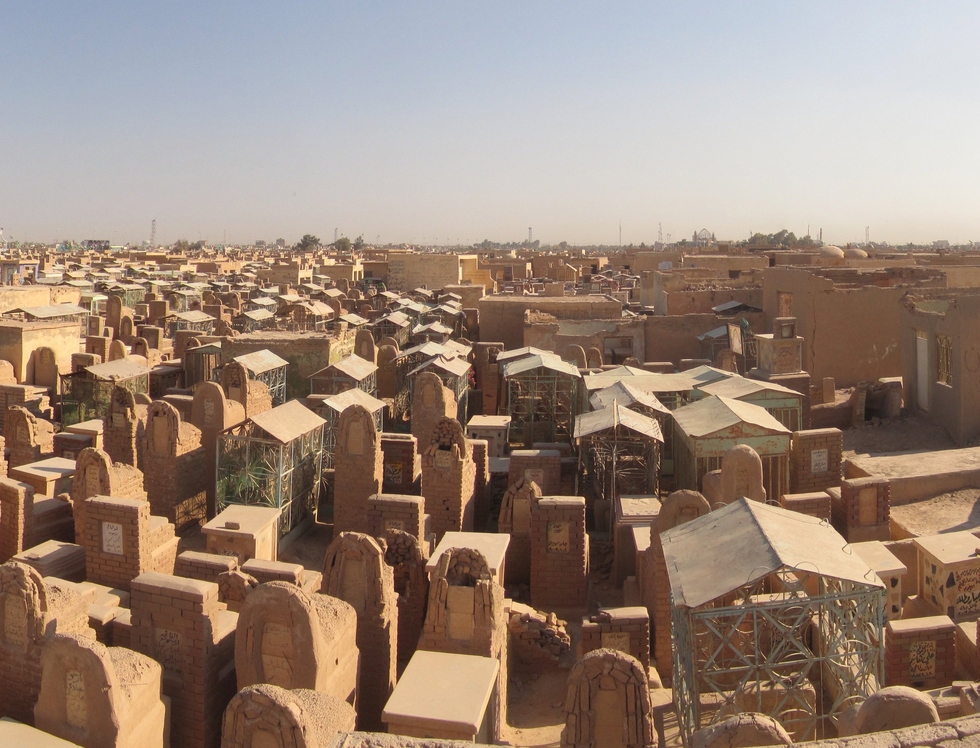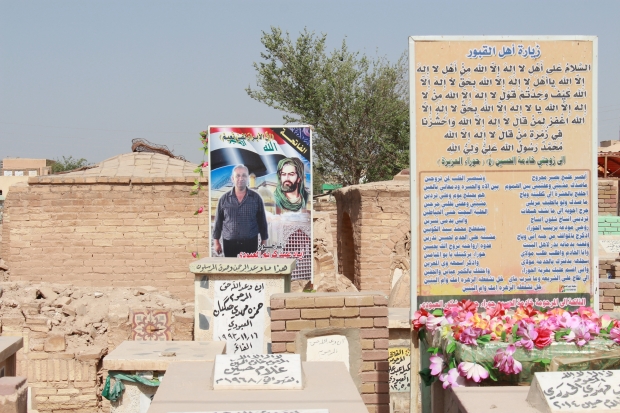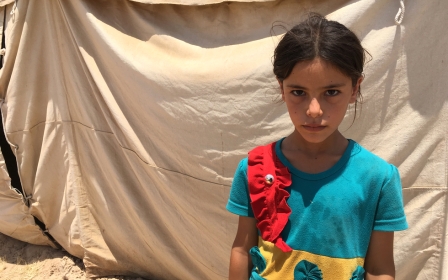World's largest cemetery receives '100 bodies a day' from fighting in Iraq

NAJAF, Iraq - As far as the eye can see, gravestones, tombs and Shia icons stretch out amid the baking summer heat. This is the Al-Salam Valley cemetery, the largest in the world, in Iraq's Najaf province.
As casualties increase in the fight to retake the Islamic State (IS) bastion of Fallujah, 200km to the south, gravedigger Hamid al-Wad says he has been busy interring the dead from the battlefield.
“In my office, I've had an increase of 13 or 14 bodies a day, but the cemetery as a whole receives more than 100 fighters daily,” al-Wad told Middle East Eye.
He is one of a group of gravediggers at the cemetery, founded 1,400 years ago and said to contain the remains of about five million people buried across six square kilometres.
The fighting between IS and the Iraqi army and its allies has led to a rising death toll across the country.
Al-Wad said the bodies of recently slain fighters come from not only Fallujah but also from “Saqlawiyah, Jurf al-Sakhar and Ramadi".
The Iraqi government does not release figures of those killed in the fighting, but a member of the security forces posted outside the cemetery told AFP that as of 1 June, more than 70 “martyrs” from the Fallujah operation had been buried.
Joel Wing, editor of the Musings on Iraq blog, said the government had an official policy of not releasing such figures in order to "keep up morale".
Fighting around Fallujah has been intense since the Iraq army, allied Popular Mobilisation Units (PMUs) and the US-led anti-IS coalition, launched their assault on the city a fortnight ago, and the death toll has been mounting.
A visit to any of the shrines that are dotted around Iraq will often coincide with mass mourning for new "martyrs". Draped in the Iraqi flag, men say prayers for the dead only metres away from the tombs of ancient fallen heroes of Shia tradition including Ali, Hussein and Abbas.
As it is located near the shrine of Imam Ali, the son-in-law of the Prophet Muhammad and second-most revered figure in Shia Islam, many want to be buried in the cemetery.
Among the most-visited graves are those of Grand Ayatollah Mohammad Mohammad Sadeq al-Sadr, killed in an ambush in 1999, whose son Moqtada al-Sadr would in 2004 seize the Imam Ali shrine in defiance of the US occupation authorities.
Despite the huge expanse of the graveyard, there are now signs that plots - particularly in the most prized spots closer to the Imam Ali shrine - are beginning to run out.
The price of plots in the graveyard has risen from about $1,500 for 500 square feet in 1991 to more than $10,000.
Ahmed Hassan Khaled Salah, a former biology student and now a fighter with the Abbas Battalion PMU, told MEE that the defeat of IS would coincide with the return of the Shia saviour known as the Mahdi.
"One year, that is enough, and we are waiting on one person," he said. "His name is the Mahdi. We are waiting on him and when he comes we will start fighting with him, God willing."
"We are defending our religion, but we prioritise defending our nation," he added.
The names of the numerous militias suggest a distinctly Shia Islamic flavour to the conflict.
The Abbas Battalion was founded by the Abbas shrine in Karbala after a call to arms by Grand Ayatollah Ali Sistani for units to form and fight against IS. The likes of Kataeb Hezbollah (Party of God Battalions), the Ali Akbar Brigades, Liwa Abu al-Fadhal al-Abbas, the Mahdi Army and others all denote the leanings of those involved in the fighting.
"The truth is always targeted," said Ahmed Hassan, the former biology student. "No one wants the truth to prevail."
The millions of bodies that reside in Al-Salam Valley testify to the fervour with which Iraqi's Shia espouse their faith and their desire to be buried near their religious forebears.
Its continuing expansion is also a memorial to the hundreds of thousands who have died since 2003 at the hands of the US occupation forces, former Baathists, in inter-sectarian warfare and fighting against IS.
The graveyard is not likely to lose its appeal as the burial site of choice for Shia, but many may hope that when the war against IS is finally over, the influx of bodies might slow for the first time in many years.
This article is available in French on Middle East Eye French edition.
Middle East Eye propose une couverture et une analyse indépendantes et incomparables du Moyen-Orient, de l’Afrique du Nord et d’autres régions du monde. Pour en savoir plus sur la reprise de ce contenu et les frais qui s’appliquent, veuillez remplir ce formulaire [en anglais]. Pour en savoir plus sur MEE, cliquez ici [en anglais].







